

The Belmont Stakes, a key fixture in American horse racing, is renowned for its rich history and challenging course. As the oldest and longest race in the Triple Crown series, it tests the endurance and skill of every horse and jockey that competes.
Known as “The Test of the Champion,” the Belmont Stakes holds a special place in the hearts of racing fans and continues to be a sporting calendar highlight each year. This article will explore this prestigious race’s fascinating history and unique aspects.
Founding and Early Years
The Belmont Stakes was first held at Jerome Park Racetrack in 1867, marking the beginning of one of horse racing’s most storied traditions. This inaugural event was made possible by the vision of Leonard Jerome, a prominent stock market speculator, and the financial backing of August Belmont Sr., a distinguished financier and sportsman for whom the race is named.
In the early years of the Belmont Stakes, the race’s location changed as it sought a permanent home. In 1890, the race moved to Morris Park Racecourse in Westchester County, where it continued to build its reputation.
However, the relocation to Belmont Park in 1905 established the race’s enduring legacy. Situated in Elmont, New York, just outside the borough of Queens, Belmont Park offered a more extensive, state-of-the-art facility to host the race for generations to come.
Throughout its history, the Belmont Stakes has seen various changes in distance, reflecting the evolving nature of the sport and the quest to test the limits of equine endurance. Initially, the race was run at different lengths, but since 1926, it has been consistently held at 1.5 miles (approximately 2,400 meters).
This distance, the longest of the Triple Crown races, has solidified the Belmont Stakes’ reputation as a test of stamina and fortitude, challenging horses to perform at their peak over a demanding course.
Significance in the Triple Crown
The Belmont Stakes is crucial as the final race in the Triple Crown series. Unlike the Kentucky Derby and the Preakness Stakes, which focus on speed and agility, the Belmont Stakes is much longer and tests the endurance of three-year-old Thoroughbreds.
Winning the Belmont Stakes is a considerable achievement, especially for horses aiming for the Triple Crown. After two tough races, this race is the deciding factor, and only the best-prepared horses can succeed. Securing a win here means the horse and jockey have conquered the most formidable challenge in American horse racing, making it a crowning moment in their careers.
Notable Moments in Belmont Stakes History
One of the most legendary moments in Belmont Stakes history was 1973 when Secretariat won by an incredible 31 lengths, setting a world record time that still stands. This victory proved Secretariat to be one of the greatest racehorses ever.
Other notable winners include Seattle Slew, who won the Triple Crown in 1977 and was the first to do so while remaining undefeated. In 2015, American Pharoah ended a 37-year drought by winning the Triple Crown, cementing his place in horse racing history.
The Belmont Stakes is also famous for its unexpected upsets. In 2002, War Emblem stumbled at the start and lost his chance at the Triple Crown. After securing victories in the first two races, funny Cide failed to win the Belmont the following year.
One of the most dramatic upsets happened in 2004 when Smarty Jones (Derby and Preakness winner) was overtaken by Birdstone in the final stretch, losing the Triple Crown in a heartbreaking finish.
These historic wins and surprising upsets highlight why the Belmont Stakes is known as the toughest race in the Triple Crown series. Every race brings excitement and unpredictability, making it a must-watch event in horse racing and an exciting opportunity to bet 2024 Belmont Stakes.
The Challenges of the Belmont Stakes
The Belmont Stakes is renowned for its demanding 1.5-mile distance, significantly longer than the Kentucky Derby and the Preakness Stakes. This length tests the stamina and endurance of the horses, making it an actual “Test of the Champion.” Many horses find this distance daunting, and it often separates the good from the great.
Held in early June, the Belmont Stakes is the final leg of the Triple Crown, and by this time, the horses have already competed in two grueling races. The timing of the race, combined with varying track conditions, adds to the challenge, requiring both physical and mental resilience from the horses and their jockeys.
Preparing for the Belmont Stakes involves a unique training regimen tailored to build the horse’s stamina and endurance. Trainers and jockeys must strategize carefully, considering the race’s length and the competition’s strength. The positioning of the horse and the timing of their move for the lead are critical factors that can determine the race’s outcome.
Takeaway
The enduring legacy of the Belmont Stakes is a celebration of excellence in horse racing. It encourages enthusiasts and newcomers alike to appreciate this iconic event’s blend of tradition, strategy, and athleticism. As we look forward to future races, the Belmont Stakes remains a symbol of the highest aspirations in the sport, challenging each participant to rise to the occasion and etch their name in history.


